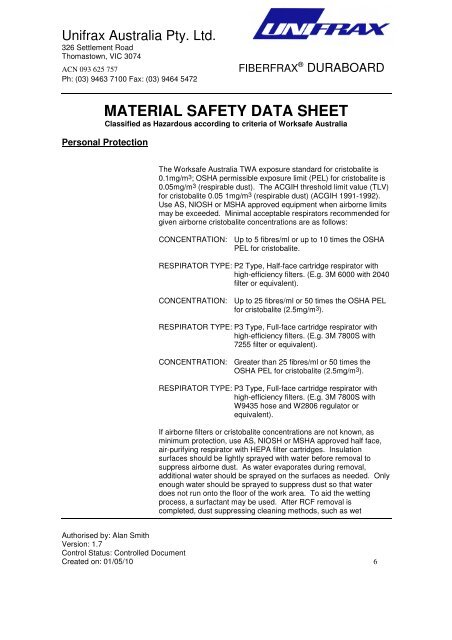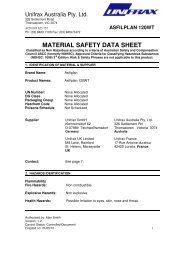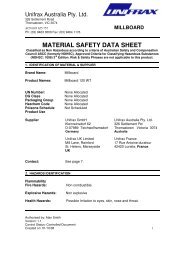MATERIAL SAFETY DATA SHEET - Unifrax Australia
MATERIAL SAFETY DATA SHEET - Unifrax Australia
MATERIAL SAFETY DATA SHEET - Unifrax Australia
Create successful ePaper yourself
Turn your PDF publications into a flip-book with our unique Google optimized e-Paper software.
<strong>Unifrax</strong> <strong>Australia</strong> Pty. Ltd.<br />
326 Settlement Road<br />
Thomastown, VIC 3074<br />
ACN 093 625 757 FIBERFRAX ® DURABOARD<br />
Ph: (03) 9463 7100 Fax: (03) 9464 5472<br />
<strong>MATERIAL</strong> <strong>SAFETY</strong> <strong>DATA</strong> <strong>SHEET</strong><br />
Classified as Hazardous according to criteria of Worksafe <strong>Australia</strong><br />
Personal Protection<br />
The Worksafe <strong>Australia</strong> TWA exposure standard for cristobalite is<br />
0.1mg/m 3; OSHA permissible exposure limit (PEL) for cristobalite is<br />
0.05mg/m 3 (respirable dust). The ACGIH threshold limit value (TLV)<br />
for cristobalite 0.05 1mg/m 3 (respirable dust) (ACGIH 1991-1992).<br />
Use AS, NIOSH or MSHA approved equipment when airborne limits<br />
may be exceeded. Minimal acceptable respirators recommended for<br />
given airborne cristobalite concentrations are as follows:<br />
CONCENTRATION: Up to 5 fibres/ml or up to 10 times the OSHA<br />
PEL for cristobalite.<br />
RESPIRATOR TYPE: P2 Type, Half-face cartridge respirator with<br />
high-efficiency filters. (E.g. 3M 6000 with 2040<br />
filter or equivalent).<br />
CONCENTRATION: Up to 25 fibres/ml or 50 times the OSHA PEL<br />
for cristobalite (2.5mg/m 3).<br />
RESPIRATOR TYPE: P3 Type, Full-face cartridge respirator with<br />
high-efficiency filters. (E.g. 3M 7800S with<br />
7255 filter or equivalent).<br />
CONCENTRATION: Greater than 25 fibres/ml or 50 times the<br />
OSHA PEL for cristobalite (2.5mg/m 3).<br />
RESPIRATOR TYPE: P3 Type, Full-face cartridge respirator with<br />
high-efficiency filters. (E.g. 3M 7800S with<br />
W9435 hose and W2806 regulator or<br />
equivalent).<br />
If airborne filters or cristobalite concentrations are not known, as<br />
minimum protection, use AS, NIOSH or MSHA approved half face,<br />
air-purifying respirator with HEPA filter cartridges. Insulation<br />
surfaces should be lightly sprayed with water before removal to<br />
suppress airborne dust. As water evaporates during removal,<br />
additional water should be sprayed on the surfaces as needed. Only<br />
enough water should be sprayed to suppress dust so that water<br />
does not run onto the floor of the work area. To aid the wetting<br />
process, a surfactant may be used. After RCF removal is<br />
completed, dust suppressing cleaning methods, such as wet<br />
Authorised by: Alan Smith<br />
Version: 1.7<br />
Control Status: Controlled Document<br />
Created on: 01/05/10 6






